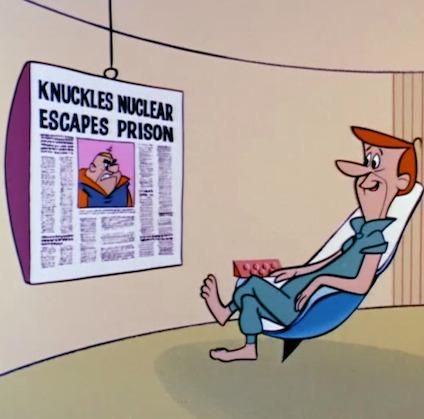BOB GARFIELD: As any regular OTM listener knows, we often discuss “present and future business models for monetizing the newspaper industry.”
[JINGLE]
But rarely do we visit the past to see what folks thought future business models might be. For instance, in a late 1960s TV special about the 21st century home, Walter Cronkite tackled the future of newspaper delivery. He got it - half right I guess.
[CLIP]:
WALTER CRONKITE: This console provides a summary of news relayed by satellite from all over the world. Now, to get a newspaper copy for permanent reference I just turn this button, and out it comes.
[END CLIP]
BOB GARFIELD: Matt Novak writes a blog for the Smithsonian called Paleofuture, about futuristic forecasts from the past. He recently wrote about old predictions for the newspaper.
MATT NOVAK: Some of the pictures that we get from past visions of the future have to do with the newspaper that will be delivered by radio. Fax papers, as they were called, were actually trialed in the 1930s and 40s, where you would have this machine that you’d set up in your house but, given the spectrum it was using, it could only [LAUGHS] be used from midnight to 6 a.m. So you had this loud clattering machine that would print out a newspaper while you were sleeping. A lot of the other predictions had to do with pneumatic tube delivery, that pneumatic tubes were a very popular vision of the future.
[BOB LAUGHS]
Actually, the Boston Globe predicted in 1900 that not only would laundry or your ready-made lunches get delivered via pneumatic tube, but also your evening newspaper.
BOB GARFIELD: The bad guesses are entertaining. The prescient looks at the future are kind of jaw-dropping. You have written about a December 1900 issue of the New York World daily newspaper. It quoted the editor of another newspaper, the London Daily Mail predicting the centralized national newspaper.
MATT NOVAK: Yeah, exactly. Alfred Harmsworth, the editor of the London Daily Mail, was saying in 1900, I feel certain that the newspaper of the 20th century will be drawn into the vortex of combination and centralization. He goes on to say, in other words, where there are now a multitude of papers, good, bad and indifferent, there will be then one or two great journals.
BOB GARFIELD: You’ve written about a 1994 video from Knight Ridder which had a laboratory dedicated to developing the future. We're, we’re talking about 19 years ago, still pretty much the infancy of the Internet. But they describe the iPad.
[KNIGHT RIDDER CLIP]:
SPOKESWOMAN: Tablets will be a whole new class of computer. They’ll weigh under two pounds. They’ll be totally portable. They'll have a clarity of screen display comparable to ink on paper. We may still use computers to create information, but we’ll use the tablet to interact with information - reading, watching, listening.
[END CLIP]
MATT NOVAK: What’s interesting about that Knight Ridder video is that it was actually used in the Apple versus Samsung patent [LAUGHS] war of the century here. You know, Apple sued Samsung, saying that they were copying their designs for their phones and their tablets. And Samsung countered with, well, here's prior art. You know, this is your iPad. So it's interesting to see these sorts of futuristic concepts pop up in real world disputes over [LAUGHS] intellectual property.
BOB GARFIELD: The tablet in the Knight Ridder video showed a newspaper on the page, it shows being able to click through to more details in the story. It showed being able to click through to video. It showed related stories that were immediately loaded onto the page – just kinda nailed it. But [LAUGHING] it got one thing hilariously wrong.
[CLIP:]
SPOKESWOMAN: We envision kiosks that will download your publications onto electronic cards that go inside the tablet. So if you are doing business in Miami but your hometown is Denver, you can still get your local paper delivered every morning.
[END CLIP]
BOB GARFIELD: Completely missed! [LAUGHS]
[NOVAK LAUGHS]
Completely missed, in the Internet age the notion of Internet distribution of every paper.
MATT NOVAK: Well, things like wireless delivery of newspapers were still the realm of sci-fi. There’s a lot of accounts from the early 90s where people just didn't believe that broadband Wi-Fi would be a reality, even within, you know, 20 years.
BOB GARFIELD: So you have made a study of these artifacts. I'm curious to know what your favorite prediction is, accurate or off target.
[JETSONS THEME MUSIC UP AND UNDER]
MATT NOVAK: I often go back to The Jetsons. You know, they obviously have the jet packs, the meal pills. They also had dedicated machines for every different technology that today we have sitting in our pockets, whether that was the videophone or whether that was the newspaper machine. You know, it descended from the ceiling and George sits down in his comfortable chair and reads the newspaper.
BOB GARFIELD: I guess the only thing the smartphone does not do is give you a dog treadmill –
[NOVAK LAUGHS]
- outside the apartment. Matt, thank you very much.
MATT NOVAK: Thanks, Bob. I appreciate it.
BOB GARFIELD: Matt Novak writes the Paleofuture blog for Smithsonian.com.
[THE JETSONS CREDITS CLIP]:
GEORGE JETSON/ON DOG TREADMILL: Help! Help! Jane, stop this crazy thing! Hey, help me!
[END CLIP]
[MUSIC UP AND UNDER]

